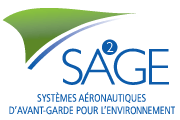FLYING LABORATORY (PM1)
The Flying Laboratory — Phase 2 project is the result of a collaboration between the companies ARA Robotics, Bombardier and CMC Electronics resulting from phase 1 of the Flying Laboratory project. The project consists of developing a drone platform for a single pilot, autonomous or ground station assisted aerial systems; using aerodynamically advanced scaled down flight test vehicles and developing cockpits and avionics systems to test new technologies.
Drone Platform
ARA Robotics will continue the development activities of the drone platform by adapting communication and control technologies, autonomous navigation, infrastructure, and aerial data capture platform. It will also contribute to the development of the ground station and the integration of ARA-CMC technology. With the help of Bombardier and CMC, ARA will contribute to the evolution of several obstacle detection and landing site assessment modules applicable to mining and infrastructure construction. This optimization and prediction software will help advance advanced aircraft architectures.
Scaled-Down Flight Test Vehicles
Bombardier is building on the achievements of the first phase of the Flying Lab project, with a second phase focused on the improvement and use of small-scale flight test vehicles to evaluate advanced aerodynamic shapes for GHG emission reduction. Complementary technology building blocks necessary to achieve GHG emission reduction goals will be developed: a technology simulator will be commissioned, providing a test environment for the demonstration of next-generation integrated aircraft control systems, and an engineering tool development cycle will be completed. The project makes extensive use of a network of SMEs in Quebec for the scale models and provides numerous learning opportunities for students.
Cockpits and Avionics Systems
CMC will continue to evolve ground-based cockpit applications (new interfaces), navigation and positioning functions and technologies to make aircraft more autonomous. For example, sensors, processors, and software will be developed for landing, avoidance, and obstacle detection solutions.
In conclusion
The development of the drone platform, the scaled-down flight test vehicles and the cockpits and avionics systems will allow the creation of new technologies related to the automation and autonomy of aircraft that will be beneficial to both the Quebec drone sector and to aeronautics more globally, notably by improving the ecological footprint.


